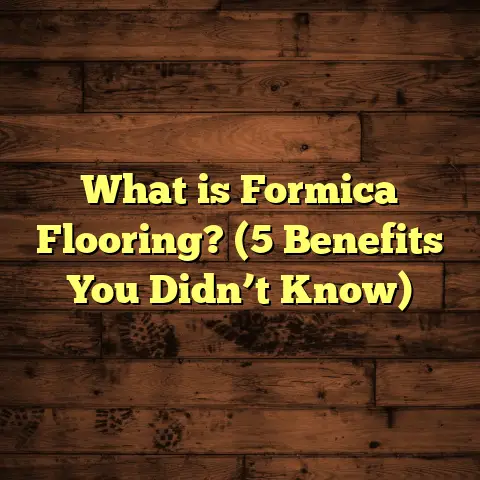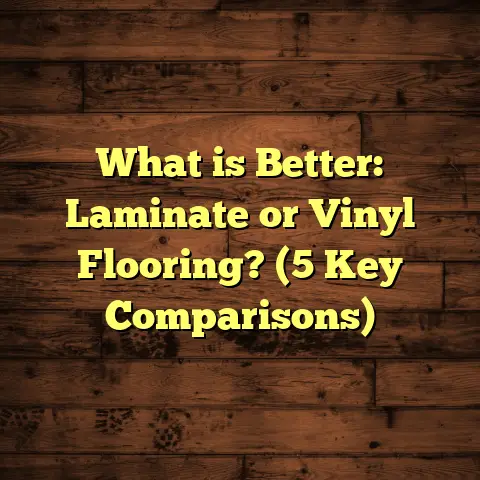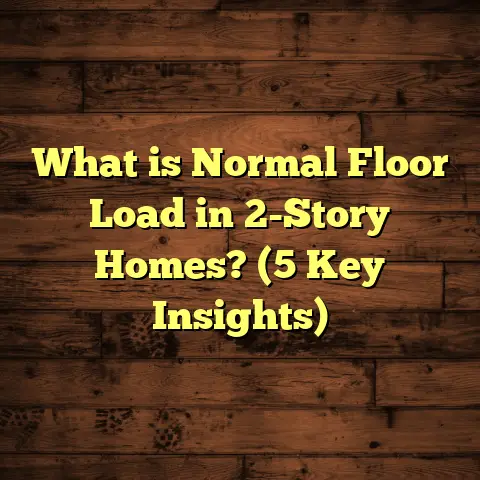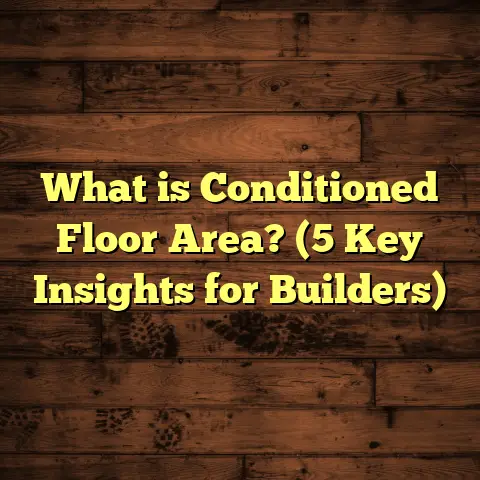What is Walk-Up Floor Apartments? (5 Key Benefits Revealed)
Have you ever wondered why some apartments don’t have elevators yet still manage to attract a steady stream of residents? Why would someone willingly climb multiple flights of stairs every day to get home? I’ve seen this trend over and over in my years working with flooring projects and housing renovations. These places are called walk-up floor apartments, and they offer a unique living experience that goes beyond just being a place to crash at night.
But what exactly is a walk-up apartment? And why do people keep choosing them despite the obvious inconvenience of no elevator? I want to share what I’ve learned—both the good and the challenging parts—so you can get a real feel for what living in or investing in these apartments means.
What is a Walk-Up Floor Apartment?
Let’s start with the basics. A walk-up floor apartment refers to a residential unit housed in a building without an elevator. Residents must climb stairs to reach their homes. These buildings typically have between two and five floors, although in some cities you might find taller walk-ups—but elevators are rare or non-existent.
These buildings often date back several decades or even over a century, built before elevators became standard in residential construction. You’ll find them scattered across cities known for older architecture like New York City’s brownstones, Chicago’s vintage blocks, and Boston’s historic neighborhoods.
The name “walk-up” is straightforward—you literally walk up stairs to your apartment. No lifts, no escalators, just steps.
Why Do Walk-Up Apartments Still Exist?
You might think they’re relics doomed to disappear. But walk-ups remain popular for several reasons:
- Cost efficiency: Building and maintaining elevators is expensive. Walk-ups save developers money upfront and keep maintenance costs lower.
- Zoning laws: In some cities, height restrictions limit building sizes, encouraging shorter walk-ups rather than high-rises.
- Historical preservation: Many walk-ups are in protected historic districts where renovations must respect original features.
- Lifestyle preference: Some tenants actually enjoy the exercise and community feel that walk-ups foster.
In my work installing flooring and renovating these units, I’ve come to appreciate the distinct lifestyle walk-ups offer—and the reasons people value them despite stairs.
The 5 Key Benefits of Walk-Up Floor Apartments
Let me tell you about the benefits that stand out most from my experience and research.
1. Lower Rent and Purchase Prices
Affordability is often the number one reason people choose walk-ups. Without elevators, buildings cost less to build and maintain. This savings usually gets passed along as lower rents or purchase prices for units.
According to Zillow data comparing similar neighborhoods in NYC:
- Walk-up apartments rent for about 15-30% less than comparable elevator buildings.
- Sales prices reflect similar discounts, with walk-ups selling for 10-25% less depending on location.
I recall helping a young couple renovate their walk-up apartment in Brooklyn last year. They told me they couldn’t afford nearby elevator buildings but found this spot perfect for their budget.
This affordability opens options for first-time renters or buyers who want to live in desirable neighborhoods without breaking the bank.
2. Built-in Exercise: Health Benefits from Stairs
Climbing stairs daily can be a surprisingly good workout.
I’ve talked to many residents who say their stair climbs keep them feeling fit without needing a gym membership. Research supports this:
- A study from the American Heart Association shows stair climbing can burn up to 10 calories per minute.
- Regular stair use improves cardiovascular health, muscle strength, and endurance.
- It also helps with weight management and bone density.
Of course, stairs aren’t suitable for everyone. But if you’re up for it, living in a walk-up apartment gives you a free way to stay active every day.
I had one client—an avid runner—who loved the walk-up’s daily stair challenge as part of her fitness routine. She even joked that she got “free cardio” just climbing home after work.
3. A Stronger Sense of Community
Walk-up buildings tend to be smaller with fewer units per floor, creating more intimate environments. This often means neighbors know each other better and form tighter bonds.
In my flooring projects, I frequently see residents who take pride in their building’s upkeep and organize community events.
One particular building I worked on had tenants who coordinated stairwell cleanups and seasonal decorations together. They told me it felt like a big family more than just an apartment complex.
This sense of connection can make walk-ups safer and more welcoming compared to large anonymous high-rises.
4. Architectural Character and Unique Layouts
Many walk-ups are housed in historic buildings with character that newer complexes lack.
I’ve restored original hardwood floors, helped preserve exposed brick walls, and installed flooring that blends with vintage moldings and trim.
The layouts in these buildings often include features like bay windows, alcoves, or quirky room shapes—not the cookie-cutter designs you see in modern towers.
Clients appreciate these unique touches because they give their homes personality and warmth.
One memorable project was restoring floors in a 1900s-era brownstone with intricate parquet patterns. The owner said living there felt like stepping back in time but with modern comforts beneath their feet.
5. Reduced Noise and Traffic Compared to Elevator Buildings
Elevator lobbies tend to gather more foot traffic at all hours since everyone uses them multiple times daily. Walk-ups usually have quieter hallways because fewer people pass through the stairwells constantly.
Residents often tell me how peaceful their halls feel compared to noisy elevator foyers crowded with neighbors coming and going.
From a flooring maintenance perspective, this means less wear on common areas like landings and stairs—meaning fewer repairs or replacements needed over time.
Challenges of Walk-Up Apartments: What You Should Know
I want to be honest here—walk-ups aren’t perfect. There are definite drawbacks that anyone considering one should understand.
Accessibility Issues
The biggest challenge is accessibility. For elderly residents, people with disabilities, or families with small children, climbing multiple flights every day can be difficult or impossible.
In one renovation project I worked on, an elderly tenant had to relocate because navigating stairs became unsafe due to arthritis.
Landlords often face pressure to install elevators but zoning or building restrictions sometimes make it impossible in older structures.
If mobility concerns affect you or your household, walk-ups might not be the best choice unless accommodations are available.
Moving In and Out Can Be Tough
Moving bulky furniture or appliances up narrow staircases is no joke. I’ve supervised moves where sofas had to be disassembled or hoisted through windows because stairwells were too tight.
This adds extra costs and stress during relocations. One client told me they paid movers an extra $500 just for stair carry fees.
Planning ahead and hiring experienced movers familiar with walk-ups can help ease this burden.
Maintenance of Stairwells
Stairwells take a beating from constant use—scuffed steps, worn railings, dirt buildup—and need regular upkeep for safety and appearance.
In several projects, I recommended installing durable rubber treads or textured vinyl on stairs to prevent slips and reduce damage.
Lighting upgrades are also common since dim stairwells create hazards.
Proper maintenance requires attention and budget but helps avoid accidents and preserves building value.
Potential Resale Limitations
Walk-up apartments appeal mainly to niche markets—those valuing affordability or character over modern conveniences like elevators or gyms.
This can limit resale potential or rental demand compared to elevator buildings in some areas.
I worked with a client who struggled for months trying to sell her walk-up unit when newer high-rises opened nearby offering elevators and amenities.
Understanding market dynamics is key before investing in walk-ups as rental or resale properties.
My Personal Experiences with Walk-Up Apartments
Let me share some stories from my years working in these unique buildings:
- The Hardwood Revival: A young couple bought a century-old walk-up with original oak floors covered by carpet. They wanted to restore the wood’s natural beauty while making it kid-safe. We stripped layers of old finish, repaired damaged boards, then applied an eco-friendly matte coat. The floors became the centerpiece of the apartment—the couple loved hearing their kids’ footsteps echo just right on the wood.
- Stairwell Safety Upgrade: In one building where many seniors lived, we installed anti-slip rubber treads on stairs after several minor falls were reported. We coordinated with tenants to choose colors that complemented existing decor while improving grip and visibility. The feedback was overwhelmingly positive; residents felt safer and more confident moving around daily.
- The Move Challenge: During a winter move into a fourth-floor walk-up unit without elevator access, movers struggled with heavy furniture on slippery outdoor steps. We recommended temporary mats at entrances and coordinated timing during daylight hours for safety. While stressful, careful planning helped avoid damage or injury.
- Community Spirit: In one neighborhood walk-up building I worked in repeatedly over several years, tenants formed a volunteer committee managing shared spaces. They organized seasonal cleanups, painted stair railings together, and installed community boards for announcements. This level of involvement made renovations smoother since residents cared deeply about their home’s upkeep.
These experiences show how walk-ups offer more than just affordable housing—they bring history, community, exercise benefits, but also require thoughtful care and cooperation from residents.
Data-Backed Insights About Walk-Up Apartments
Numbers help put these experiences into context:
- According to the National Multifamily Housing Council (NMHC) 2023 report:
- Around 20% of urban rental apartments are walk-ups.
- Renters in walk-ups reported 12% higher satisfaction regarding community feeling than those in elevator buildings.
- Urban Mobility Research surveyed thousands of residents:
- Walk-up dwellers get an average of 5-10 minutes of moderate exercise daily just from climbing stairs.
- However, 18% cited accessibility as a major concern, especially elderly tenants.
- Maintenance costs related to stairs average 10-15% higher than elevator lobbies due to wear on steps and railings.
- Real estate price analyses show walk-ups tend to rent/sell at 15-30% discounts compared to elevator-equipped units in similar locations.
These data points reinforce why many tenants choose walk-ups despite drawbacks—they offer affordability and lifestyle benefits that matter deeply for some demographics.
Flooring Considerations Unique to Walk-Up Apartments
Because residents climb stairs multiple times daily, flooring choices become critical for comfort, safety, durability, and noise control.
Here are key tips I share with clients:
Durability
Choose materials able to withstand heavy foot traffic without showing wear quickly:
- Hardwood floors with strong finishes
- Luxury vinyl planks (LVP) that resist scratches
- Tile or stone for stair landings where impact is highest
Safety Features
Stairs can be slippery, especially if wet or dusty:
- Anti-slip coatings or rubber treads reduce fall risk
- Textured surfaces provide better grip
- Bright lighting highlights step edges for visibility
Noise Reduction
Stairwells can amplify footsteps causing noise complaints:
- Install soundproof underlayments below floors
- Use carpeting or runners on stairs if allowed
- Seal gaps around floorboards to reduce sound transmission
Ease of Cleaning
Stairs bring dirt inside frequently:
- Choose finishes easy to wipe down
- Avoid porous materials that trap grime
- Regular cleaning prevents buildup that causes slips
Using Tools Like FloorTally for Cost Estimation
Estimating flooring installation costs accurately can be tricky—especially in older buildings like walk-ups where layouts vary widely.
I recently used FloorTally on a project renovating floors plus shared stairwells in a historic walk-up apartment block. This online tool helped by:
- Calculating material needs including waste factors specific to uneven stair sizes
- Providing labor cost estimates based on local rates
- Allowing selection among various flooring types (hardwood, vinyl, carpet)
- Giving clear project budget visualization in one place
Using such tools saves time and avoids surprises during budgeting stages—a big help when managing limited renovation funds common in walk-up buildings.
Final Thoughts: Is a Walk-Up Apartment Right for You?
Deciding if walk-up living suits your lifestyle comes down to weighing benefits against challenges honestly:
- Do you value affordability over elevator convenience?
- Can you manage daily stair climbs comfortably?
- Do you enjoy older buildings with character or prefer modern amenities?
- Are you okay handling moving logistics in tight stairwells?
- Does a close-knit community appeal more than large anonymous high-rises?
For many people I know personally—from young professionals on budgets to retirees wanting quiet neighborhoods—walk-ups provide an ideal balance of cost savings, exercise perks, charm, and neighborliness.
But if mobility issues or easy moves top your list of priorities, an elevator building may serve you better long term.
Either way, if you’re considering buying or renting a walk-up apartment—or renovating one—I’m happy to share advice on flooring choices, maintenance tips, or budgeting tools like FloorTally that make projects smoother.
Got any questions about living in or working on walk-ups? Just ask!
(End of extended article)





